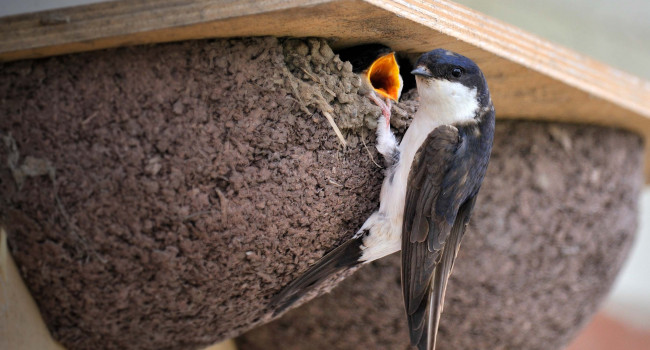Garden BirdWatch and our garden and urban bird research
Thanks to our dedicated BTO Garden BirdWatch participants we now have a complete quarter-century of weekly garden bird observations from the length and breadth of the country, richly contributing to the BTO’s wider research on urban environments.


Select to enlarge
Nuanced effects of garden feeding
A key focus of our work has been to understand the impact of garden bird feeding on bird populations and communities in and around our gardens. Thanks in part to the generous support of Garden BirdWatchers, this work has shown that practices of garden bird feeding have changed radically over the last 40 years, leading to significant changes in the bird communities that visit our gardens, and even contributing to national-scale population changes. For example, analysis of GBW data has shown that providing fats and sunflower hearts has contributed to the increasing use of gardens by Blackcaps in winter, and has led to them evolving a new migration route. Related research has shown that garden feeding not only improves over-winter survival rates, but also impacts the subsequent condition of birds which may even affect their ability to breed successfully a few months later.
However, there is much more to understand. Garden feeding can also have negative consequences for some individuals, depending upon the quality of the food put out, and particularly the hygiene associated with feeding stations. In particular, feeders can be a source of exposure to diseases such as trichomonisis. We need to understand these components better, and particularly to test the extent to which changes in our feeding practices can moderate some of these risks, which have been shown to threaten country-wide populations of finches and other species.
Goldfinch (ranking change: +12)
In the 1980s Goldfinches were in decline, but from 1990 their numbers have been increasing dramatically. There are now two and a half times as many Goldfinches in the UK as there were 25 years ago, and they have moved from the 20th most common species in GBW to the eighth. It’s assumed that this is mainly due to these birds exploiting garden food supplies, initially niger seed and later sunflower hearts, though there may be other factors at play.
Another aspect of our garden work is to understand the impact that the management of our gardens has upon wildlife. Our information about garden habitats means we can consider the impact that different aspects of garden management have upon the wildlife that use our gardens, and from that, understand the contribution that wildlife-friendly gardening can make to biodiversity conservation across the country.
Song Thrush (ranking change: -8)
In February 1996 Song Thrushes were recorded in over half of GBW gardens, but by 2020 they were only recorded in under 15% of gardens in January, their peak month. In September 2019 only 3% of GBW gardens held this species. Song Thrushes have shown the biggest drop down the GBW rankings in 25 years, dropping out of the top 20 altogether. Despite their loss from gardens, they are still a common bird in the wider countryside, so their disappearance from our gardens is a mystery.
Wider BTO urban research
However, gardens are only one component of the urban environment. Many people do not have access to gardens, and so the wildlife they experience is dependent upon wider features of the urban landscape. Another important strand of BTO work is therefore to look at how bird communities vary across the urban landscape, such as with housing density and with the extent and quality of greenspace. Recent analyses of Bird Atlas 2007–11 data have shown how the abundance of many bird species peak in low-density housing developments on the edge of our towns and cities, but then decline further with increasing densities of housing. Incorporating woodland and wetland habitats into the built environment can benefit certain species, and we are currently analysing our finer resolution Breeding Bird Survey data to understand in more detail how modifying the urban environment can benefit birds. Ultimately, it should be possible to devise tools and information from this work to guide the planning of new housing estates and developments, to minimise the negative impact and maximise the biodiversity benefit associated with them.
Greenfinch (ranking change: -7)
Twenty-five years ago Greenfinches were increasing nationally and in gardens, perhaps due to the rising popularity of sunflower hearts and other seed-based foods.They carried on increasing until 2006, when they were decimated by the disease finch trichomonosis, and nationally numbers are now only a quarter of what they were at their peak. Due to the losses caused by disease, GBW reporting rates have decreased from around 80% of gardens in their peak of March and April to only around 40% of gardens now.
This work is not just informative for biodiversity, but also can be used to help improve the wildlife experience that we have in our towns and cities, which is increasingly shown to be important for wellbeing. Research led by the University of Exeter in collaboration with the BTO considered how bird communities varied with measures of socio-economic deprivation. Not only did we find that bird abundance and species richness tended to be lowest in areas of greatest deprivation, we also found that these communities tended to contain the greatest proportion of species which are generally perceived negatively by people. Targeted management of greenspaces in these areas to improve them for wildlife may help address this mismatch where the poorest in society have least access to the wildlife that we value. We are at the start of a growing area of work in the urban environment, that should provide the tools to know how best to manage our gardens, greenspaces and the built environment for wildlife, and to improve access to positive wildlife experiences for all sectors of society.


The Urban Appeal - making space for birds
You can make a difference to the way humans and birds live together.










Share this page